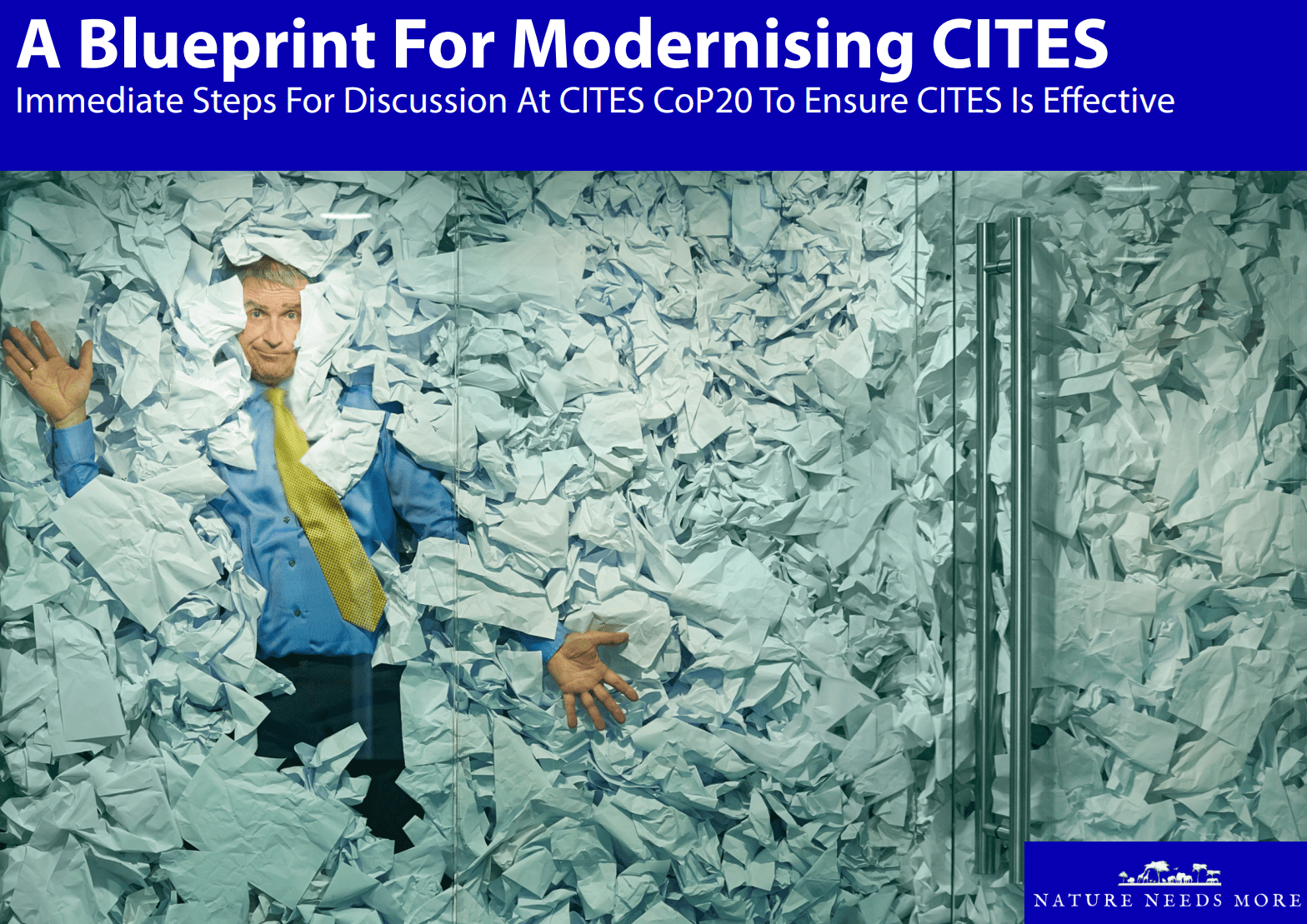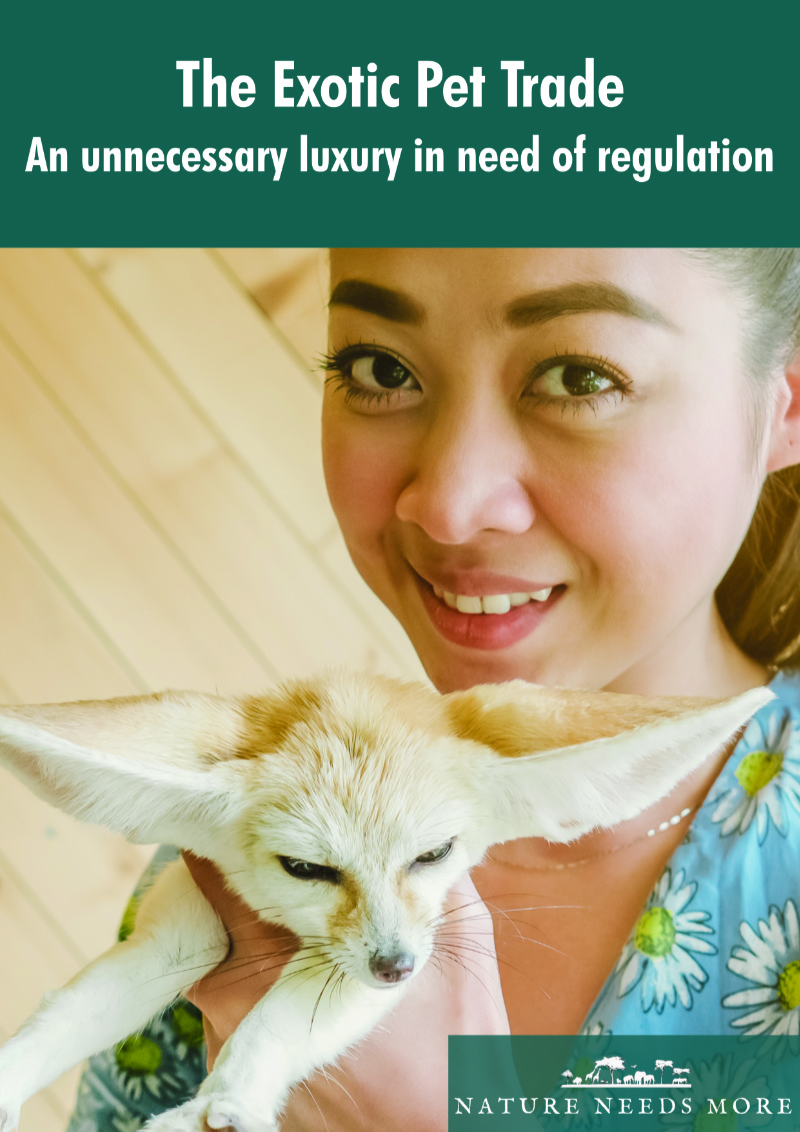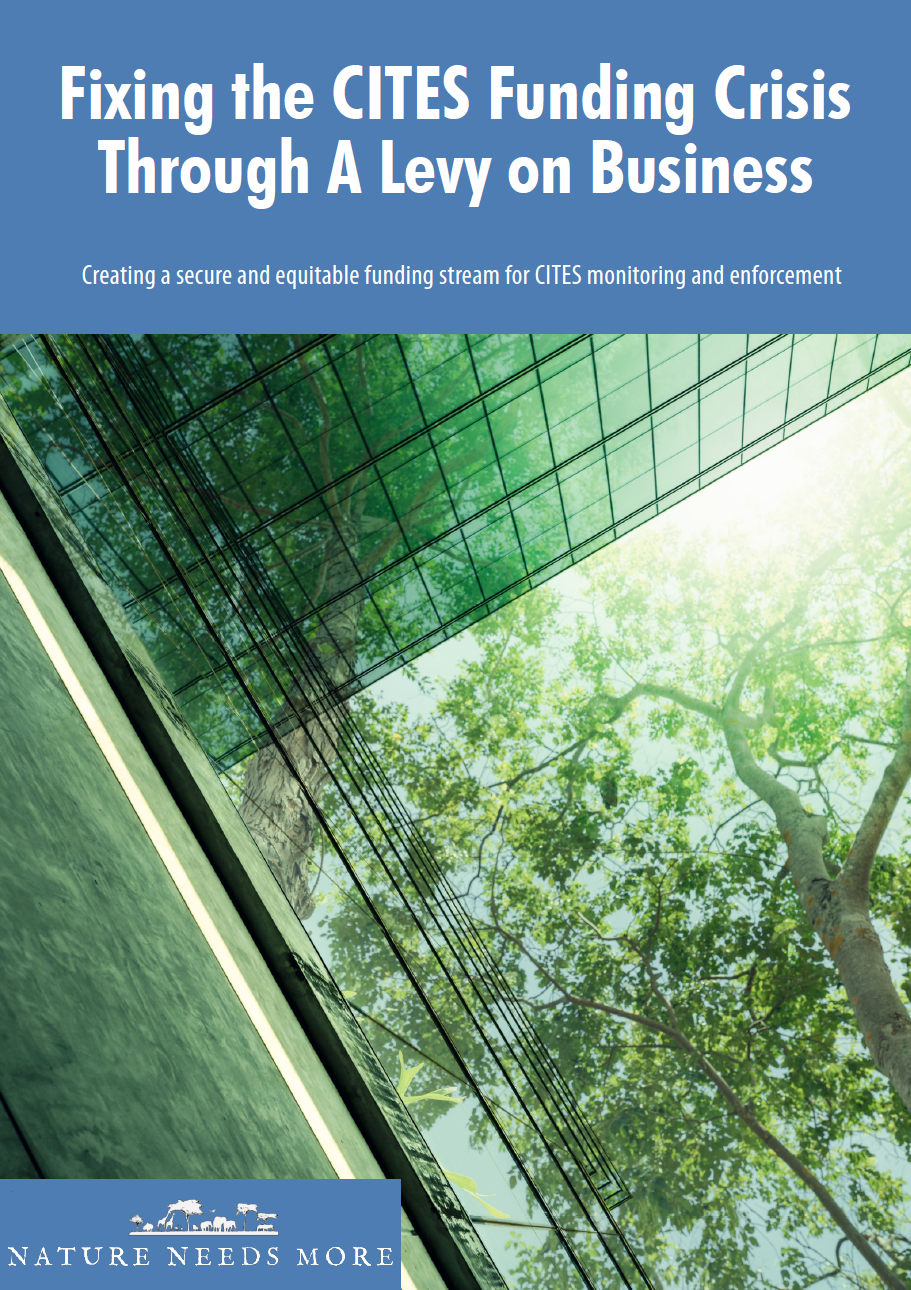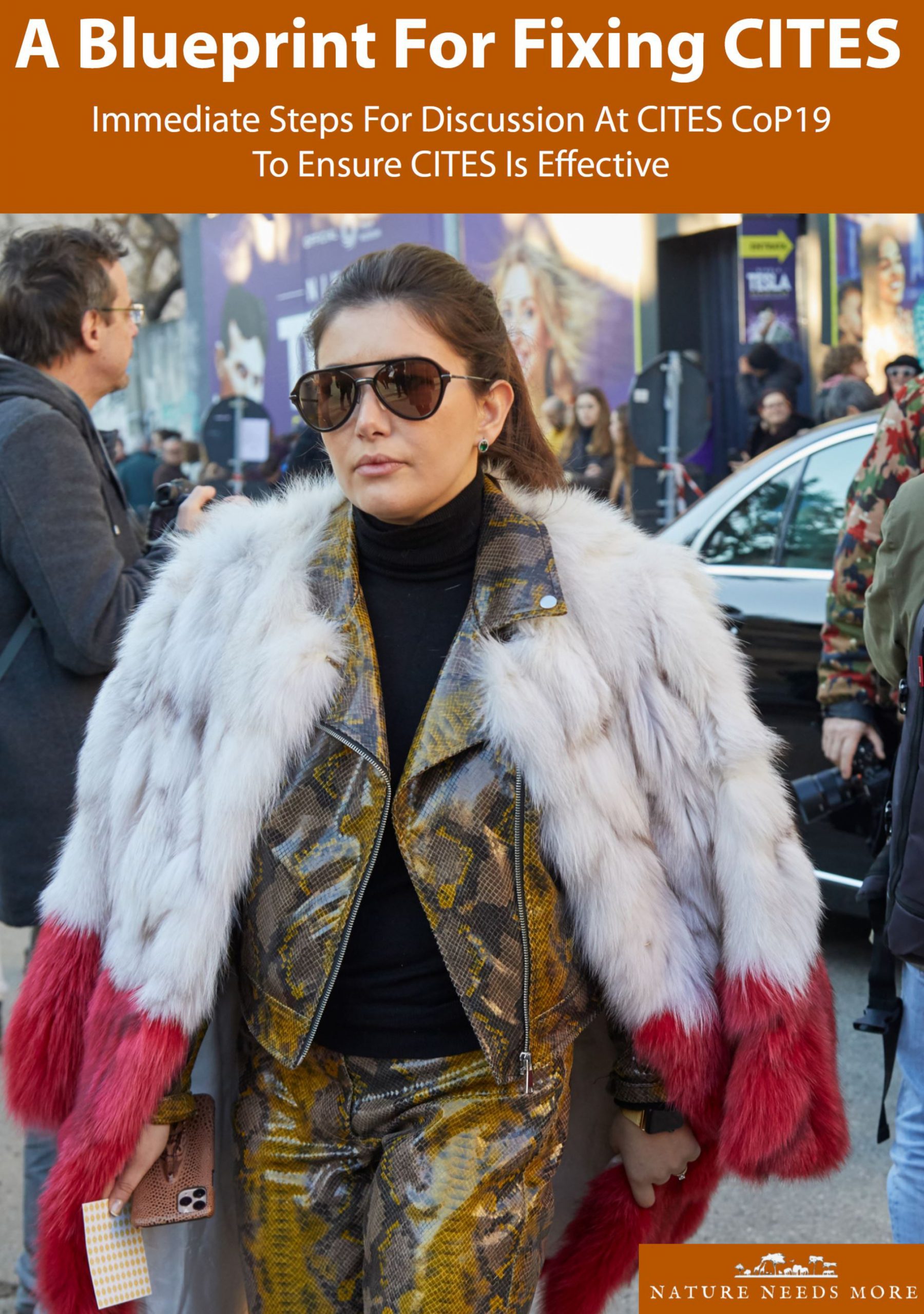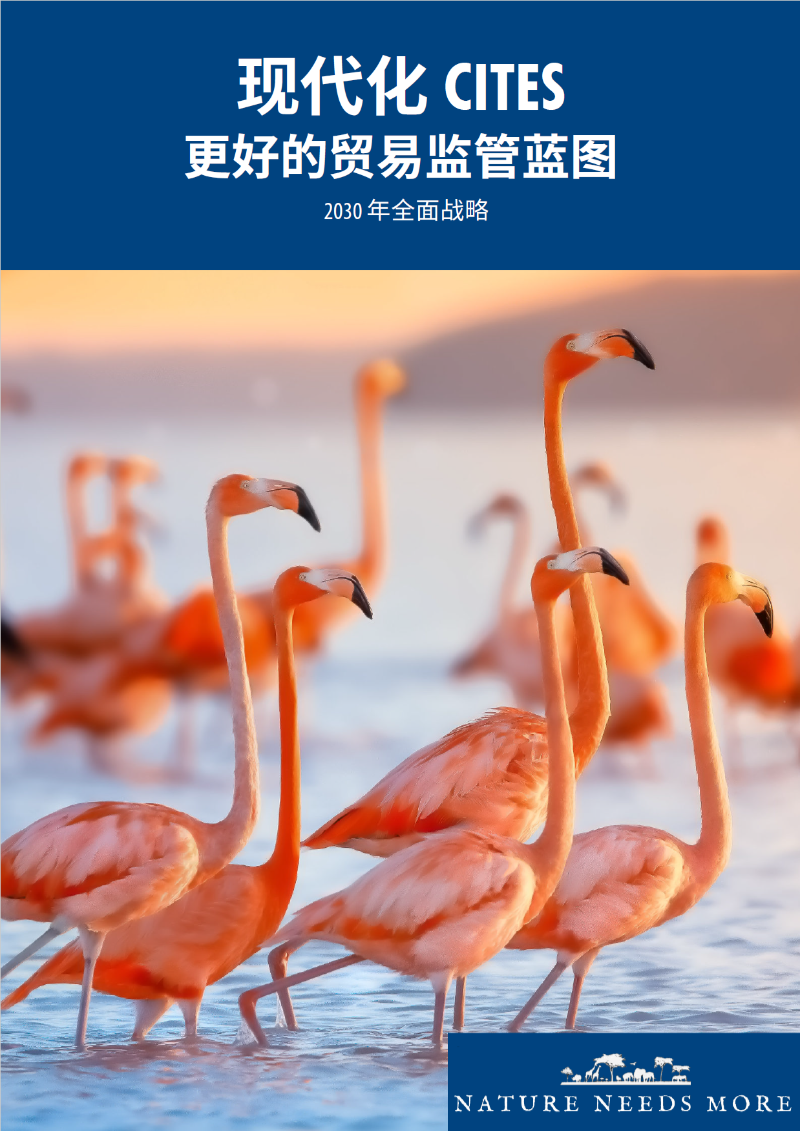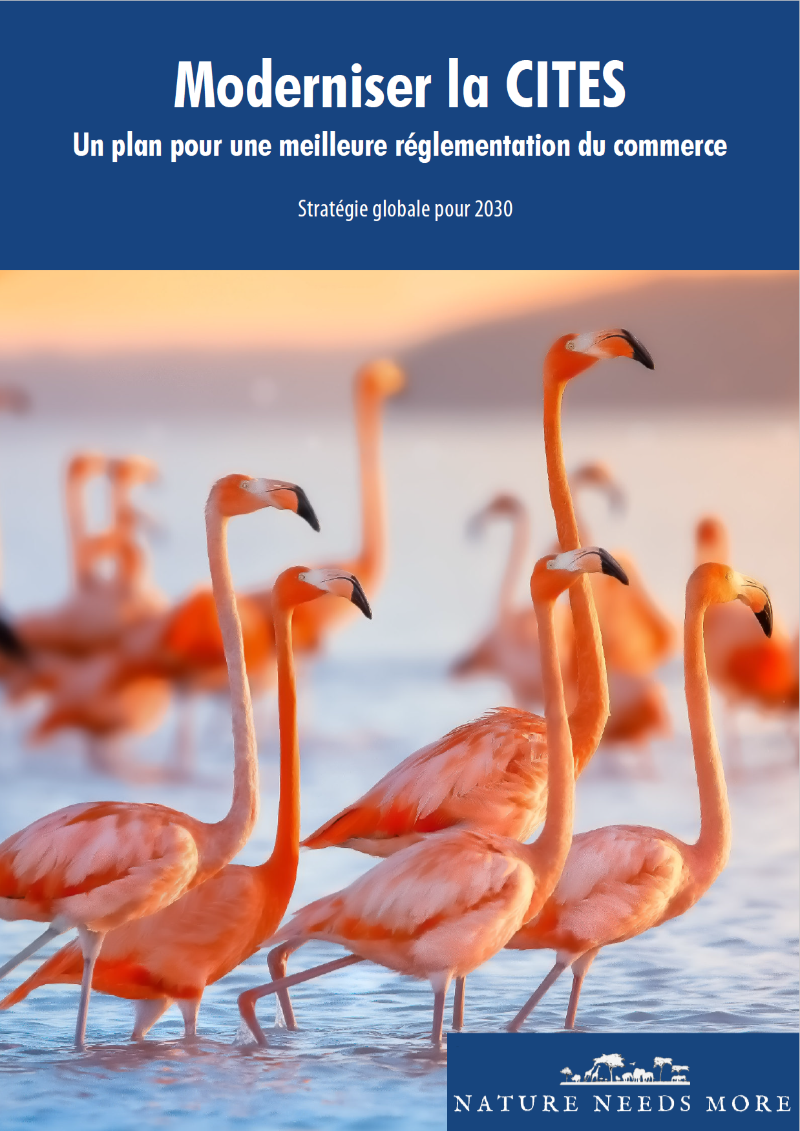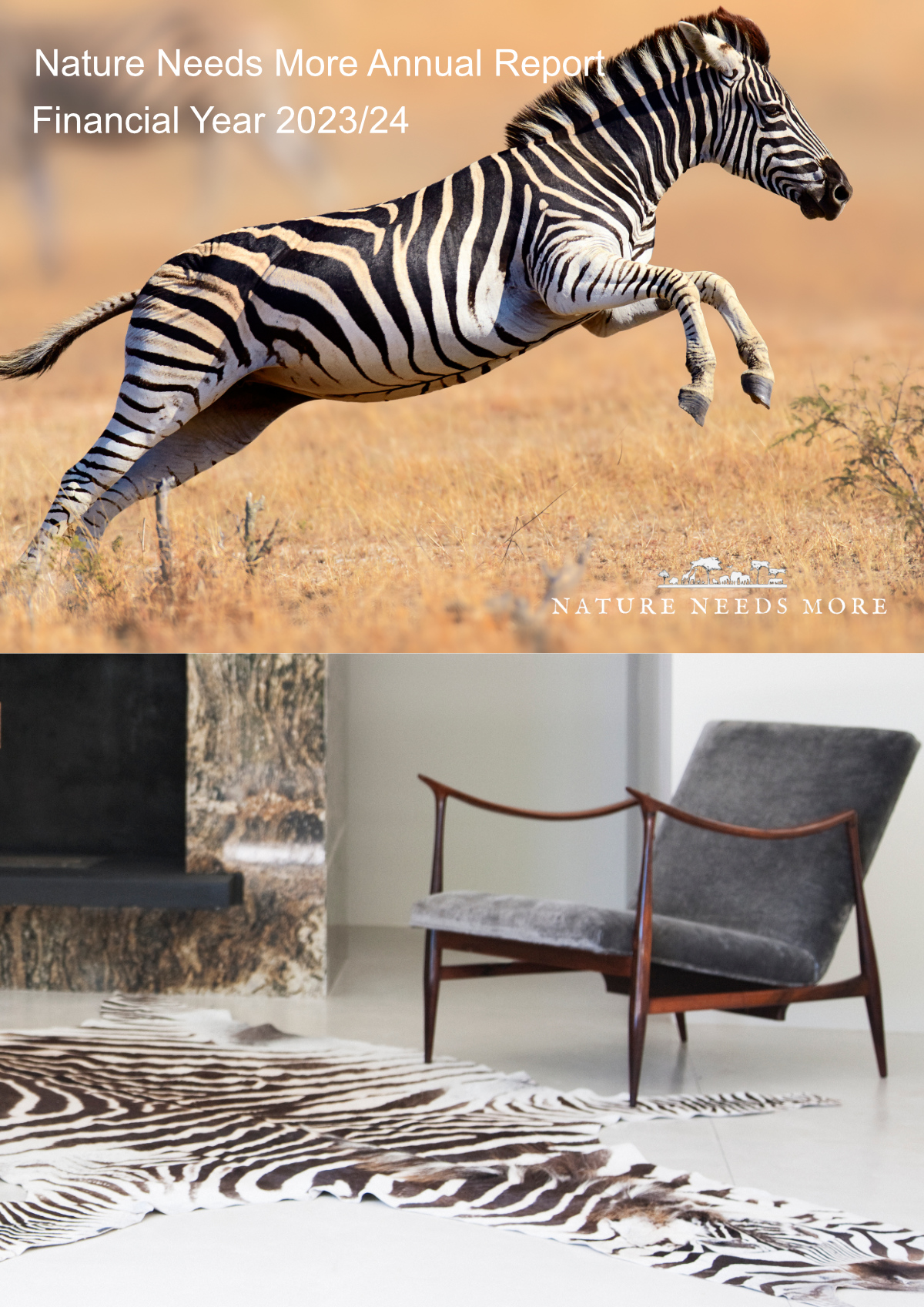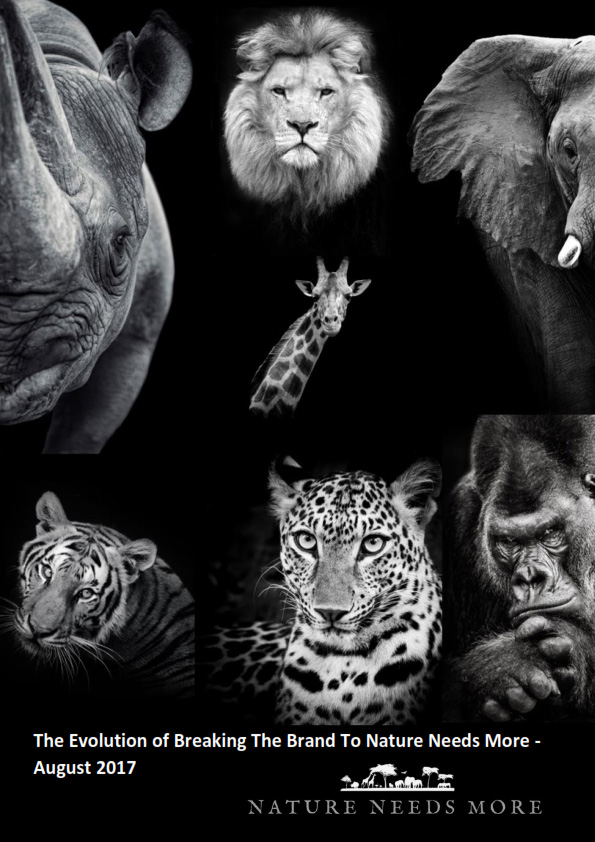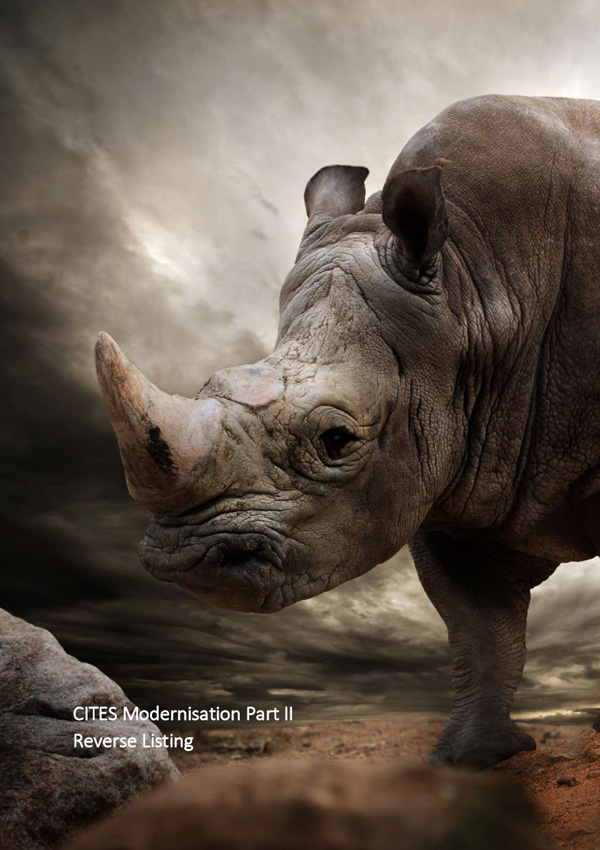Immediate Steps For Discussion At CITES CoP20 To Ensure CITES Is Effective
As we approach CITES CoP20, we need a Reality Check of CITES@50. The CITES is broke, its processes are obsolete and you have to ask if it has ever been a genuine regulator when it never mandated an Enforcement Authority. Whichever way you look at it, the CITES is in critical condition. In this context, focusing on proposals for amendment of the Appendices is akin to shuffling deckchairs on the Titanic. To address this we have published the Immediate Steps for Discussion at CoP20 and included a link to our 2024 report Fixing The CITES Funding Crisis.
Will the conservation world finally be able to face its Stockdale Paradox and confront the brutal facts of the current reality? Because phantom solutions and incremental actions won’t solve the existential crisis facing wild species and the natural world. The problems with the CITES are known. The model was flawed from the beginning, this was recognised early and a solution was proposed as far back as 1981, at CITES CoP3. If trade in wild species remains, then the only chance we have of it ever being sustainable and legal is moving to a reverse listing model and a levy on business to provide the funds needed for effective regulation. If this doesn’t happen, then Nature Needs More can with 100% certainty state that there is No Chance of achieving Target 5 of the KMGBF by 2030 and the world’s remaining wonders will continue to be nothing more than merchandise.
Reality Check CITES@50
Reality Check 1: CITES is broke – the convention cannot deliver anything for wild species until the funding crisis is solved.
Reality Check 2: The benefits of trade are unproven – invest in validating the sustainable use model or ban trade.
Reality Check 3: CITES’ processes are obsolete – it cannot deliver anything for wild species until it is modernised.
Reality Check 4: CITES is not a true regulator – it has never mandated effective enforcement in signatory countries
Reality Check 5: CITES’s strategy is obsolete – it has taken no useful steps to achieve its Vision 2030
Reality Check 6: SULi is not part of CITES – including SULi ignores the power disparities in international trade
Reality Check 7: After 50 yeas of operation, the CITES cannot prove the trade in the wild species it lists is legal or sustainable
The Exotic Pet Trade – An Unnecessary Luxury In Need Of Regulation
The exotic pet trade serves as an excellent example for what is wrong with the trade in wild species and the way it is ‘regulated’ today. Whilst in dollar terms the exotic pet trade is only a very small part of the overall wildlife trade, the fact that the species are traded live and are (mostly) relatable to people provides an opportunity to explore many of the assumptions underlying the trade in exotic and endangered species and the way the current regulatory system has been set up.
Our main aim with this report is to explore the suitability of using positive lists (which legislate the species that are allowed to be traded and owned) to better regulate the exotic pet trade. There is a strong push underway in Europe to switch to positive lists and a number of countries in the EU have implemented at least partial positive lists. Animal welfare and conservation charities are leading this push, and they predictably use animal welfare and environmental impact arguments to facilitate the change.
Unfortunately, there is little evidence that these organisations have a good understanding of regulatory frameworks and what it takes to craft legislation that can and will be enforced. They have failed to realise that without the creation of dedicated monitoring and enforcement capacity and associated funding, newly created positive lists will not be enforced, and their effort to bring in the legislation will have been wasted.
In our report we detail what additional measures need to be included in legislation to give it the best chance to succeed in curtailing the legal exotic pet trade and the illicit trade it enables. The starting point needs to be to understand both the commercial realities and the motivations of all the actors involved in the trade, the businesses, the social media influencers, and the owners. Once a positive list comes into force, large parts of the trade become illegal by default, yet the desire to supply and promote does not cease, many people’s income depends on it. That means that creating a dedicated and fully funded monitoring and enforcement framework is just as important as creating the positive list.
We argue in this report that such a monitoring and enforcement framework needs to be funded from licence and registration fees raised from both traders along the entire suppy chain and via mandatory pet registration fees from owners. None of this is new or unusual. Licence and registration schemes to fund regulators are found in any number of industries.
Domestic successes with the implementation of positive lists in individual countries in the EU will also not solve the problems in the international trade. Better international regulation is only possible via amending CITES, as positive lists are not an option without amending the articles of the convention. This might be possible via adding a protocol instead of reopening the articles for negotiation. Regardless, CITES would also need to embrace an equitable funding mechanism for monitoring and enforcement, which it currently lacks.
Fixing the CITES Funding Crisis Through a Levy on Business
In this short report we have expanded on our proposal to put a 1% levy on the value of commercial imports of Appendix I and II listed species into the major import markets. This would create a secure and equitable funding stream for CITES monitoring and enforcement, which could be distributed to national authorities via the CITES External Trust Fund. Given the urgency to fix the CITES funding crisis and to tackle the illegal trade, this proposed model is feasible under the current articles of the convention and can be implemented quickly and efficiently.
CITES is currently unable to achieve its stated objective: to keep the trade in endangered species legal and ecologically sustainable. The illegal trade is rampant, and monitoring and enforcement of the legal trade suffer from major problems starting with a broken NDF process, lack of Significant Trade Reviews, poor quality and irreconcilable trade data, and an ancient permit system not fit for the scale and value of the commercial, legal trade.
The lack of resources made available to implement and enforce CITES provisions are the most important factor leading to this failure and also enable the illegal trade to flourish. With most of the paltry funding to regulate and monitor the legal trade coming from signatory governments and with government budgets under severe pressure everywhere, there is little prospect of an increase in resources to better implement and enforce CITES. Yet without a massive funding increase, the 2030 CITES strategic vision of making all trade legal and sustainable is not achievable.
In this brief report we show how these problems can be tackled without the need to reopen the articles of the convention. At the heart of these proposals is the realisation that the CITES trade is overwhelmingly a luxury trade and that the businesses ultimately profiting from this trade a large luxury companies and conglomerates. These companies are concentrated in handful of markets (US, EU, China/HK, Japan, and UK), which are also the major import markets for wildlife products. Thus, putting a small levy on the value of imports into these markets can raise hundreds of millions of dollars every year which can be allocated to national authorities to improve monitoring and enforcement of CITES provisions.
Such a levy can be raised in an efficient manner via mandating import permits for Appendix II species in these jurisdictions and setting the permit fee to 1% of the value of the shipment as declared to customs. The main import countries would further need to agree to remit the equivalent of, say, 80% of the proceeds from such a scheme to the CITES External Trust Fund. The import country would retain 20% of the proceeds to cover the cost of administering the collection of the levy and also to better monitor and regulate their domestic CITES trade.
We argue in this report that such a monitoring and enforcement framework needs to be funded from licence and registration fees raised from both traders along the entire supply chain and from owners through mandatory pet registration fees. None of this is new or unusual. Licence and registration schemes to fund regulators are found in any number of industries.
Domestic successes with the implementation of positive lists in the EU will not solve the problems in the international trade in exotic pets. Better international regulation is only possible via amending CITES, as positive lists are not an option without amending the articles of the convention. This might be possible via adding a protocol instead of reopening the articles for negotiation. Regardless, CITES would also need to embrace an equitable funding mechanism for monitoring and enforcement, which it currently lacks.
The Business of Nature – Holding Big Business to Account for the Overexploitation of Biodiversity
The global trade in wild species is perceived to be both relatively small and well-regulated (by CITES). Our The BU$IN€$$ of Nature report shows that this global commercial trade is in fact massive and that it is conducted by or on behalf of large corporations and some of the biggest global brands. Only a very small component of the trade is regulated by CITES, the two largest trades by value – seafood and timber – are basically unregulated. CITES does not regulate businesses, which means that the companies doing the biomass extraction are not subject to any direct regulation to counteract their desire to grow both revenue and profit. And the trade in nature is one of the most profitable trades in the world.
Lack of supply chain transparency, poor quality and incomplete trade data and the absence of monitoring and enforcement for the little regulation there is in place has resulted in this trade becoming utterly unsustainable. Deforestation in tropical forests equates to the eradication of some of the most diverse ecosystems on Earth. At least half of all fisheries are overfished and 10% are on the brink of collapse. Despite fifty years of CITES, trade has not turned around the fortunes of the wild cohort of species valued by industry. The trade in exotic skins, such as from the Siamese crocodile, is a perfect example of the failure of CITES.
With mounting evidence that we are already causing the 6th mass extinction event and the IPBES warning of up to 1 million species of being at risk of extinction in the near future, surely we are in crisis already, and legal commercial trade is the key driver. The landmark May 2019 IPBES report into the global extinction crisis confirmed that direct exploitation for trade is the most important driver of decline and extinction risk for marine species and the second most important driver for terrestrial and freshwater species.
Growing public awareness of biodiversity loss means businesses are also aware that they need to do something – anything – to prepare for when their years of greenwashing are going to be challenged. This is the point we are at, with the creation of a plethora of phantom solutions (offsets, credits, certifications, ESGs etc) to avoid the scale of government intervention needed to properly regulate the business of biomass extraction.
We show in this report that regulating the wildlife trade is neither hard to do nor does it require the end of capitalism. It does require remembering that we had previous periods where certain industries were subjected to drastic regulation as the result of a crisis.
The BU$IN€$$ of Nature report is available as a web version (23MB) and a print version (38MB).
Immediate Steps For Discussion At CITES CoP19 To Ensure CITES Is Effective
This document outlines urgent measures that can be adopted by the Conference of the Parties to vastly improve the effectiveness of CITES without the need to renegotiate the articles of the convention. The Short-Term Priorities highlighted, which are possible under the current model, should all be implemented by CITES 50th year of enforcement in 2025. Only with this can CITES retain any form of relevance and credibility in line with its stated objective and primary vision for 2030.
Summary Of Recommendations
Number 1: Fix The Funding Crisis
Short-Term Priorities:
- Apply A 1% Levy To Imports To Major Import Markets
- Create A Register Of Businesses Trading Under CITES
- Reverse The Burden Of Proof
Number 2: Improve Monitoring, Traceability And Analytics
Short-Term Priorities:
- Global Rollout Of Electronic Permitting
- Trade Analytics Reporting
- Source To Destination Tracking
- Increase Reviews Of Significant Trade
Number 3: Enable Effective Enforcement In All Countries
Short-Term Priorities:
- Dedicated Enforcement Authority
- Enforcement And Prosecution Funds
- Targeted Trade Sanctions
Number 4: SULi Is NOT Part Of The Convention
Short-Term Priorities: Decouple Conservation Objectives From Poverty Alleviation
Number 5: Positive Lists For The Live Animal Trade
Short-Term Priorities: Adopt A Protocol To Use Positive Lists For The Trade In Live Animals
Modernising CITES – A Blueprint for Better Trade Regulation
CITES has failed in its stated objective of protecting endangered species from overexploitation through trade, with trade being the primary extinction driver for marine species and the second most important driver for terrestrial and freshwater species. Whilst the lack of funding to enforce CITES provisions has long been known as a key reason for this, blaming the illegal trade is a convenient excuse to ignore the crucial design flaws in the current CITES model.
Nature Needs More decided to fully investigate the reasons why CITES is failing and becoming more ineffective as the number of species in need of protection continues to rise. We researched regulatory models in other industries and the history of regulatory failures to draw conclusions about the suitability of the basic building blocks of the current CITES framework – blacklisting, national sovereignty and it being a non-self-executing treaty. We demonstrate that with those basic building blocks remaining in place, CITES cannot be effective and cannot arrest the decline in populations.
We then outline a new regulatory framework for CITES based on whitelisting, regulating business directly and businesses paying the full cost of regulation. The model we present makes business responsible for internalising compliance, yet keeps companies at arm’s length from the regulator and the regulatory process. We offer a detailed account of how this model would work in practice, under real life conditions. We show that it is financially viable, providing US$9-13.5 BILLION annually to regulate, manage, monitor and enforce the trade. Finally we offer a path for CITES signatory countries to make it happen, acknowledging the difficulty involved in opening the articles for re-negotiation.
The report is available in all official UN languages – Arabic, Chinese, French, Russian and Spanish.
Debunking Sustainable Use Report
The May 2019 IPBES Report into the global state of biodiversity made it abundantly clear that our current patterns of extracting biomass from nature are unsustainable, with up to 1 million species threatened with extinction. The direct exploitation of plants and animals is the second biggest factor driving the extinction crisis, after land use (habitat destruction). Yet since its publication there has been no change in relation to the unrelenting focus on ‘sustainable use’ of wildlife. Even COVID-19 doesn’t seem to have been enough for the industries, businesses and governments desperate to nudge us back into pre-pandemic consumption patterns and business-as-usual to learn. The scale of the inertia is quite staggering.
Nature Needs More decided to dig deeper into the magical claims of the ‘win-win-win’ sustainable use model and highlight how the current institutional settings continue to preference economic growth over both ecological sustainability and social justice outcomes. Our Debunking Sustainable Use Report 2020 focuses on the international trade in endangered wildlife and how the lack of effective regulation under CITES and the tacit tolerance of the illegal wildlife trade combine to ridicule any claims of sustainability.
The story of ‘sustainable use’ starts from a fundamentally flawed assumption – that there can be a win-win-win scenario between economic, ecological and social benefits. Unlimited growth is impossible on a limited planet, so all ‘use’ of nature has to be based on managing the available ‘stock’ for current and future generations. This cannot be done under a capitalist model of private property rights over nature’s resources, it requires a commons management framework. We provide short, medium and long term solutions to reversing the present trends, which are currently driving the catastrophic declines in biodiversity.
Nature Needs More Annual Reports
Our Annual Reports contain a summary of our project work and initiatives. We would like to take this opportunity to highlight this work could not have been done without our supporters and donors. We can’t thank them enough for all their encouragement.
Nature Needs More directors all volunteer their time to the organisation.
Nature Needs More Published Papers
Re-Inventing Magnificence: Gaining Status from Contribution Not Consumption
Nature Needs More’s Founder, Dr Lynn Johnson, was delighted to be invited to be a part of an international collaboration exploring the implications of excessive, unchecked luxury consumption. The paper can be purchased here.
Abstract
Most luxury consumers link rarity to higher status. It may be a luxury car, yacht, haute-couture fashion and accessories, prestige holiday destinations such as Venice, or purchasing exotic wildlife products. For some, legal luxury is not enough to fulfil their status need and they take a step into a world of illegal consumption; this is the case for the buyers of rhino horn in Viet Nam. The desire for rare wildlife products, both legal and illegal is increasing rapidly. Legally, the desire to supply means species are both captive bred en masse and legally harvested from the wild to fulfil the demand. Illegally, criminal syndicates have moved beyond simply exploiting the existing demand to manufacturing new markets using the same principles luxury goods manufacturers have used for decades to trigger desire and purchasing decisions. Uncurtailed luxury consumption of exotic wildlife products is driving the illegal poaching and unsustainable harvesting of many species. Extinction is a direct result of the vulgarity of desire for luxury goods made from endangered species. Battling this trend requires a different approach to traditional conservation methods. Nature Needs More utilises an innovative approach to wildlife conservation, that of demand reduction. But demand reduction alone is not enough, there is a need to redirect desire away from both legal and illegal consumption of exotic and endangered species. Nature Needs More combines demand reduction campaigns in SE Asia with work to revive and reinvent Magnificence, a concept steeped in history but subverted by luxury in recent centuries. This paper outlines Nature Needs More’s research in the field, and the mechanisms by which we can provide elites with an alternative to fulfil their self-image and status needs based on contribution instead of consumption of our most fragile heritage.
Mammoth Tusk Beads and Vintage Elephant Skin Bags: Wildlife, Conservation, and Rethinking Ethical Fashion
Nature Needs More’s Founder, Dr Lynn Johnson, was delighted to collaborate with Dr Catherine Kovesi University a historian at the University of Melbourne where she researches the discourses of luxury consumption. The article explores the fact that wildlife is not currently factored in to the evolving sustainable fashion strategy. It can be purchased here.
Abstract
Recent years have seen marked consciousness-raising in the arena of ethical fashion. Despite inherent difficulties in tracing a complete ethical supply chain back to source, sustainable fashion movements have helped to highlight the need for prominent fashion industry role models on the one hand, and awareness of those who produce what we consume on the other. Yet, repeatedly in such discussions, one of the most fragile components of the luxury fashion business is left out of the conversation – wildlife and endangered species. To date there have been parallel discourses in ethical fashion and in wildlife conservation that rarely intersect, and are indeed often in unintended opposition to each other. Even those who attempt to promote an ethical path, or who buy vintage rather than new fashion items of wildlife products, often unwittingly contribute to the accelerated demand for wildlife fashion products from present-day endangered species. The desire to be ethical can, in some instances, even contribute to illegal poaching activity. This article unravels for the first time some of the complexities of the conservation dilemmas involved in the wearing of ancient, vintage, and present-day wildlife products. In doing so it argues we should place wildlife center stage, as an equally important element, in rethinking what it is that we wear.
Breaking The Brand Project Launch and Annual Reports
In August 2017 Breaking The Brand evolved and was incorporated in to one of the pillars of Nature Needs More Ltd. The final Annual Report for Breaking The Brand which includes the transition to Nature Needs More can be found at the top of the page under the Nature Needs More Annual Reports Section.

